Information Systems and ERP: Applications and Benefits Analysis
VerifiedAdded on 2020/10/22
|10
|2560
|421
Report
AI Summary
This report delves into the realm of information systems and Enterprise Resource Planning (ERP) within the context of business operations, with a particular focus on Marks & Spencer. It initiates with a categorization of diverse information systems, including Decision Support Systems, Transaction Processing Systems, Management Information Systems, and Computer-Based Information Systems, elucidating their roles in supporting various business functions. The report then transitions to an in-depth exploration of ERP systems, explaining their integrated nature and outlining various modules such as Human Resource, Purchase, Inventory, Sales, Finance, CRM, Production, and Supply Chain Management. Furthermore, it highlights the tangible benefits of ERP implementation in real-world business scenarios, such as enhanced staff efficiency, cost-effectiveness, time savings, reduced errors, data security, improved customer service, and standardized business processes. The report concludes by emphasizing the significance of information systems and ERP for organizational success, accompanied by recommendations for effective implementation and utilization.
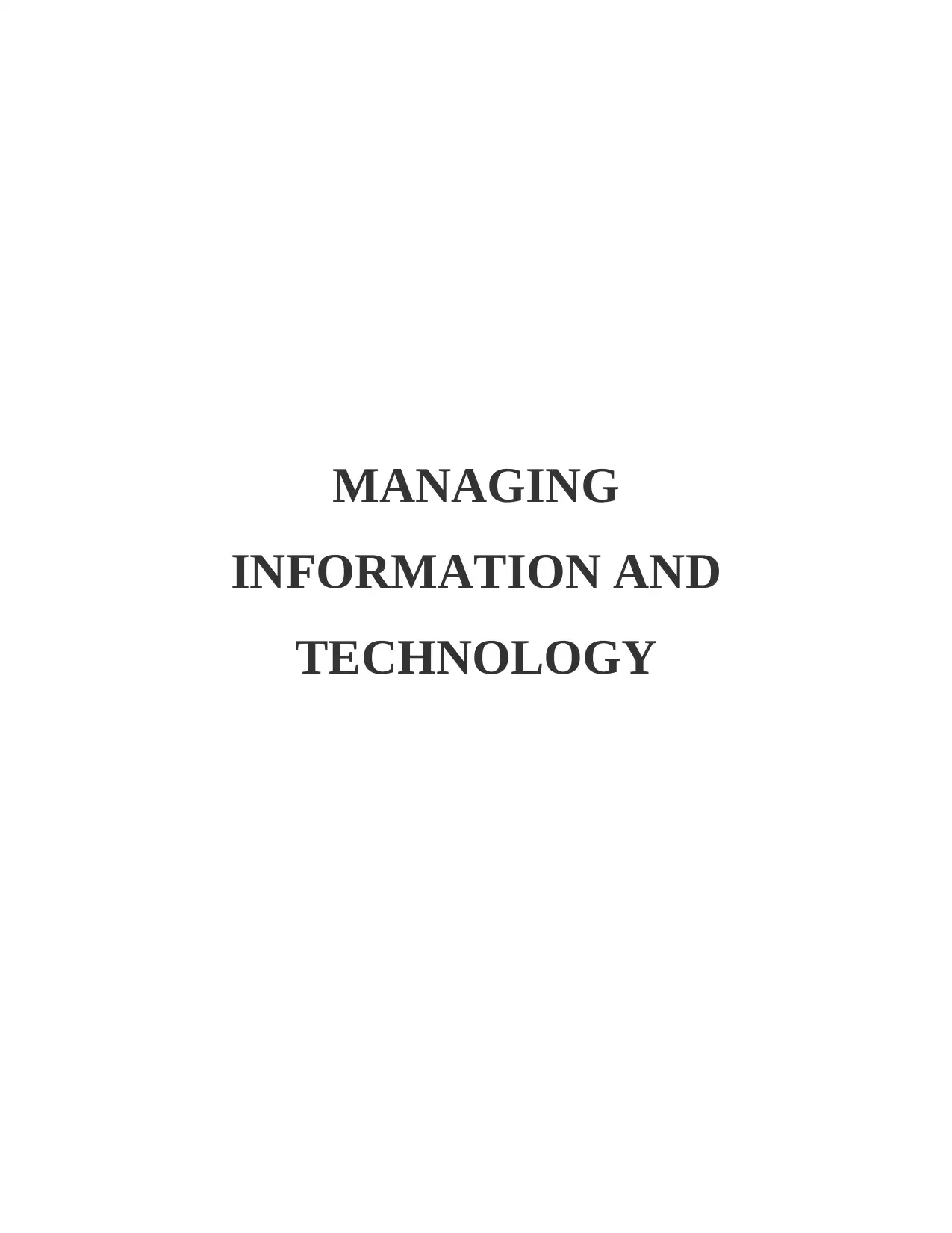
MANAGING
INFORMATION AND
TECHNOLOGY
INFORMATION AND
TECHNOLOGY
Paraphrase This Document
Need a fresh take? Get an instant paraphrase of this document with our AI Paraphraser

TABLE OF CONTENTS
INTRODUCTION...........................................................................................................................1
DISCUSSION..................................................................................................................................1
Categorization of information systems.......................................................................................1
ERP systems................................................................................................................................3
Benefits of ERP systems in a real-life business..........................................................................5
CONCLUSION ...............................................................................................................................6
RECOMMENDATIONS.................................................................................................................7
REFERENCE...................................................................................................................................8
INTRODUCTION...........................................................................................................................1
DISCUSSION..................................................................................................................................1
Categorization of information systems.......................................................................................1
ERP systems................................................................................................................................3
Benefits of ERP systems in a real-life business..........................................................................5
CONCLUSION ...............................................................................................................................6
RECOMMENDATIONS.................................................................................................................7
REFERENCE...................................................................................................................................8

INTRODUCTION
Information technology are set of variant of business software that supports business
activities, provide competitive advantages and increases efficiency of staff. Management of these
technologies refers to its selection, installation, procurement and using it effectively for variant if
business activities (Al- Jabri and Roztocki, 2015). Information technology relates to the
hardware and software which helps the business to manage and operate various processes and
functions of business. Management Information system is a system which is used in decision
making, control, coordination, analysis and visualization of the information in an organisation.
MIS is the back bone of organisation's operations which can help in gathering of data from
different online systems, analyses the information and reports data which helps management in
making decisions. MIS plays an important role in an organisation and can help in managing
different organisational functions and enhance the productivity and performance of an
organisation. The report will cover basic description to variety of Information technology in
context of Marks & Spencer, a leading retail business established in 1884 with 85000 employees
till now. The study will describe ERP systems which is a business process management software
which helps the organisation to make use of integrated system applications in order to manage
business and to automate many functions in an organisation. Present report also discusses about
the benefits of ERP system to businesses of an organization.
Aims: To discuss various types of information systems and how can ERP help in managing and
controlling organisations broad information streams.
Objective:
To provide an analysis of how ERP can help in data collection methods and enhancing
the capabilities of business.
DISCUSSION
Categorization of information systems
Businesses uses variant of Information systems to inculcate and perform various business
activities, marketing and different departmental functions. Information systems and technologies
are organizational techniques to perform all strategic activities (Asprion, Schneider and
Grimberg, 2018). Companies and organizations are achieving high competitive advantages by
inclusion of certain Information and business intelligence software. Retail businesses and
1
Information technology are set of variant of business software that supports business
activities, provide competitive advantages and increases efficiency of staff. Management of these
technologies refers to its selection, installation, procurement and using it effectively for variant if
business activities (Al- Jabri and Roztocki, 2015). Information technology relates to the
hardware and software which helps the business to manage and operate various processes and
functions of business. Management Information system is a system which is used in decision
making, control, coordination, analysis and visualization of the information in an organisation.
MIS is the back bone of organisation's operations which can help in gathering of data from
different online systems, analyses the information and reports data which helps management in
making decisions. MIS plays an important role in an organisation and can help in managing
different organisational functions and enhance the productivity and performance of an
organisation. The report will cover basic description to variety of Information technology in
context of Marks & Spencer, a leading retail business established in 1884 with 85000 employees
till now. The study will describe ERP systems which is a business process management software
which helps the organisation to make use of integrated system applications in order to manage
business and to automate many functions in an organisation. Present report also discusses about
the benefits of ERP system to businesses of an organization.
Aims: To discuss various types of information systems and how can ERP help in managing and
controlling organisations broad information streams.
Objective:
To provide an analysis of how ERP can help in data collection methods and enhancing
the capabilities of business.
DISCUSSION
Categorization of information systems
Businesses uses variant of Information systems to inculcate and perform various business
activities, marketing and different departmental functions. Information systems and technologies
are organizational techniques to perform all strategic activities (Asprion, Schneider and
Grimberg, 2018). Companies and organizations are achieving high competitive advantages by
inclusion of certain Information and business intelligence software. Retail businesses and
1
⊘ This is a preview!⊘
Do you want full access?
Subscribe today to unlock all pages.

Trusted by 1+ million students worldwide

companies like Marks and Spencer uses different information systems to manage and perform
different activities.
General Information systems that are being used by companies are-
Decision Support System: Decision Support System may be defined as type of
computerized information system which can help M&S in supporting their decision
making processes in an organisation. DDS support system includes more informed
decision making process and can provide timely solution to the problems faced by the
organisation which improve the efficiency of M&S in dealing with the problems and
adjust to the rapidly changing variable.
Transaction processing System: TPS is a software system which helps in transaction
processes in an organisation. It involves collection, retrieval, modification of all
transaction data and this system is reliable and consistent. With the help of TPS M&S can
handle several transactions in an organisation at the same time, it can help in coordinating
thousands of purchases, address information, debit accounts and can even process
customer order simultaneously. This system tracks, records and reports various
transaction processes that takes place within an organization. It inhibits two parts of
transactions, online transaction processing and real time transaction processing system.
Management Information System: This system helps company to form regular
financial reports and data. It is highly used by various organizational departments namely
2
Illustration 1: Transaction Processing System
Source: Management Information Systems - Transaction
Processing Systems, 2018
different activities.
General Information systems that are being used by companies are-
Decision Support System: Decision Support System may be defined as type of
computerized information system which can help M&S in supporting their decision
making processes in an organisation. DDS support system includes more informed
decision making process and can provide timely solution to the problems faced by the
organisation which improve the efficiency of M&S in dealing with the problems and
adjust to the rapidly changing variable.
Transaction processing System: TPS is a software system which helps in transaction
processes in an organisation. It involves collection, retrieval, modification of all
transaction data and this system is reliable and consistent. With the help of TPS M&S can
handle several transactions in an organisation at the same time, it can help in coordinating
thousands of purchases, address information, debit accounts and can even process
customer order simultaneously. This system tracks, records and reports various
transaction processes that takes place within an organization. It inhibits two parts of
transactions, online transaction processing and real time transaction processing system.
Management Information System: This system helps company to form regular
financial reports and data. It is highly used by various organizational departments namely
2
Illustration 1: Transaction Processing System
Source: Management Information Systems - Transaction
Processing Systems, 2018
Paraphrase This Document
Need a fresh take? Get an instant paraphrase of this document with our AI Paraphraser
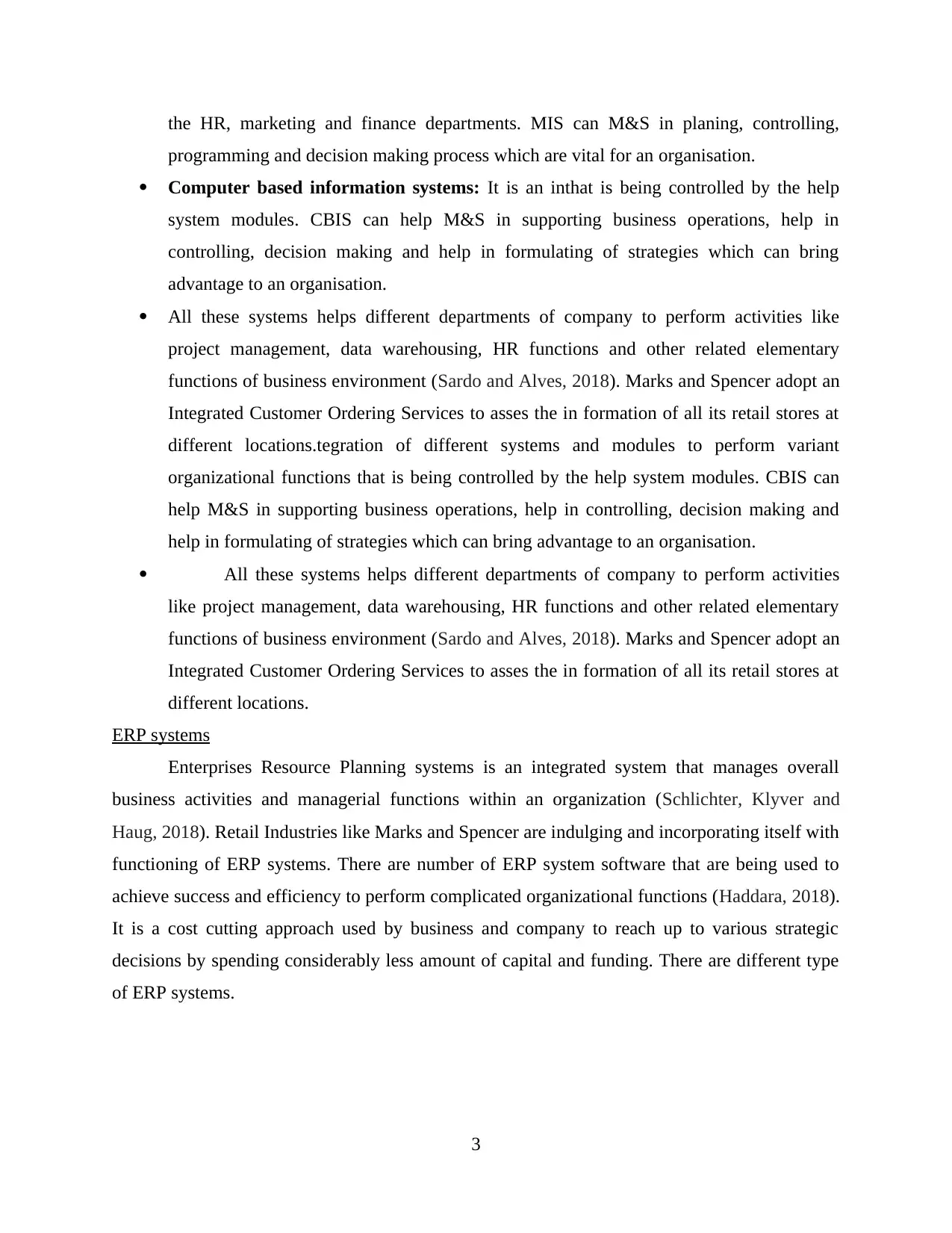
the HR, marketing and finance departments. MIS can M&S in planing, controlling,
programming and decision making process which are vital for an organisation.
Computer based information systems: It is an inthat is being controlled by the help
system modules. CBIS can help M&S in supporting business operations, help in
controlling, decision making and help in formulating of strategies which can bring
advantage to an organisation.
All these systems helps different departments of company to perform activities like
project management, data warehousing, HR functions and other related elementary
functions of business environment (Sardo and Alves, 2018). Marks and Spencer adopt an
Integrated Customer Ordering Services to asses the in formation of all its retail stores at
different locations.tegration of different systems and modules to perform variant
organizational functions that is being controlled by the help system modules. CBIS can
help M&S in supporting business operations, help in controlling, decision making and
help in formulating of strategies which can bring advantage to an organisation.
All these systems helps different departments of company to perform activities
like project management, data warehousing, HR functions and other related elementary
functions of business environment (Sardo and Alves, 2018). Marks and Spencer adopt an
Integrated Customer Ordering Services to asses the in formation of all its retail stores at
different locations.
ERP systems
Enterprises Resource Planning systems is an integrated system that manages overall
business activities and managerial functions within an organization (Schlichter, Klyver and
Haug, 2018). Retail Industries like Marks and Spencer are indulging and incorporating itself with
functioning of ERP systems. There are number of ERP system software that are being used to
achieve success and efficiency to perform complicated organizational functions (Haddara, 2018).
It is a cost cutting approach used by business and company to reach up to various strategic
decisions by spending considerably less amount of capital and funding. There are different type
of ERP systems.
3
programming and decision making process which are vital for an organisation.
Computer based information systems: It is an inthat is being controlled by the help
system modules. CBIS can help M&S in supporting business operations, help in
controlling, decision making and help in formulating of strategies which can bring
advantage to an organisation.
All these systems helps different departments of company to perform activities like
project management, data warehousing, HR functions and other related elementary
functions of business environment (Sardo and Alves, 2018). Marks and Spencer adopt an
Integrated Customer Ordering Services to asses the in formation of all its retail stores at
different locations.tegration of different systems and modules to perform variant
organizational functions that is being controlled by the help system modules. CBIS can
help M&S in supporting business operations, help in controlling, decision making and
help in formulating of strategies which can bring advantage to an organisation.
All these systems helps different departments of company to perform activities
like project management, data warehousing, HR functions and other related elementary
functions of business environment (Sardo and Alves, 2018). Marks and Spencer adopt an
Integrated Customer Ordering Services to asses the in formation of all its retail stores at
different locations.
ERP systems
Enterprises Resource Planning systems is an integrated system that manages overall
business activities and managerial functions within an organization (Schlichter, Klyver and
Haug, 2018). Retail Industries like Marks and Spencer are indulging and incorporating itself with
functioning of ERP systems. There are number of ERP system software that are being used to
achieve success and efficiency to perform complicated organizational functions (Haddara, 2018).
It is a cost cutting approach used by business and company to reach up to various strategic
decisions by spending considerably less amount of capital and funding. There are different type
of ERP systems.
3
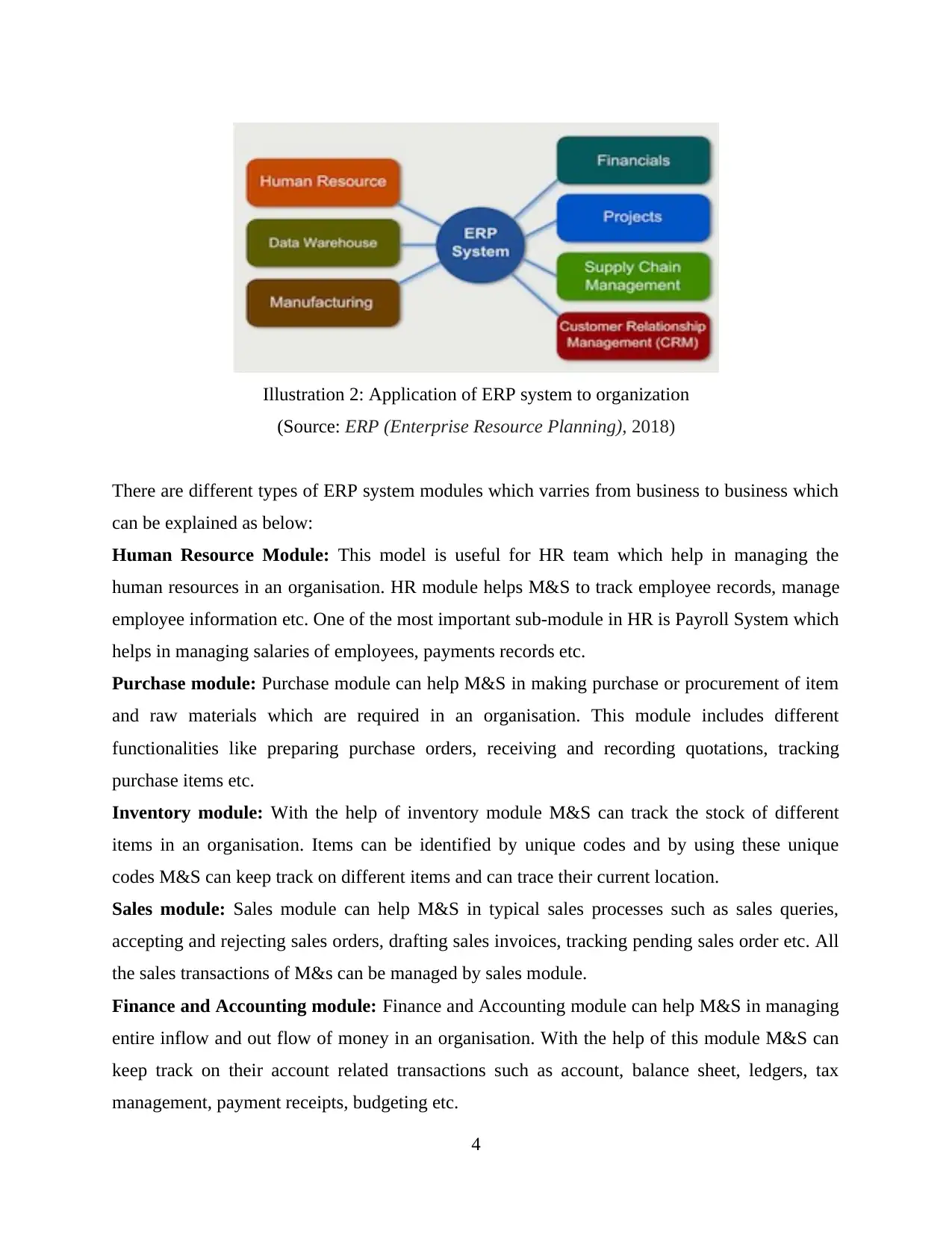
There are different types of ERP system modules which varries from business to business which
can be explained as below:
Human Resource Module: This model is useful for HR team which help in managing the
human resources in an organisation. HR module helps M&S to track employee records, manage
employee information etc. One of the most important sub-module in HR is Payroll System which
helps in managing salaries of employees, payments records etc.
Purchase module: Purchase module can help M&S in making purchase or procurement of item
and raw materials which are required in an organisation. This module includes different
functionalities like preparing purchase orders, receiving and recording quotations, tracking
purchase items etc.
Inventory module: With the help of inventory module M&S can track the stock of different
items in an organisation. Items can be identified by unique codes and by using these unique
codes M&S can keep track on different items and can trace their current location.
Sales module: Sales module can help M&S in typical sales processes such as sales queries,
accepting and rejecting sales orders, drafting sales invoices, tracking pending sales order etc. All
the sales transactions of M&s can be managed by sales module.
Finance and Accounting module: Finance and Accounting module can help M&S in managing
entire inflow and out flow of money in an organisation. With the help of this module M&S can
keep track on their account related transactions such as account, balance sheet, ledgers, tax
management, payment receipts, budgeting etc.
4
Illustration 2: Application of ERP system to organization
(Source: ERP (Enterprise Resource Planning), 2018)
can be explained as below:
Human Resource Module: This model is useful for HR team which help in managing the
human resources in an organisation. HR module helps M&S to track employee records, manage
employee information etc. One of the most important sub-module in HR is Payroll System which
helps in managing salaries of employees, payments records etc.
Purchase module: Purchase module can help M&S in making purchase or procurement of item
and raw materials which are required in an organisation. This module includes different
functionalities like preparing purchase orders, receiving and recording quotations, tracking
purchase items etc.
Inventory module: With the help of inventory module M&S can track the stock of different
items in an organisation. Items can be identified by unique codes and by using these unique
codes M&S can keep track on different items and can trace their current location.
Sales module: Sales module can help M&S in typical sales processes such as sales queries,
accepting and rejecting sales orders, drafting sales invoices, tracking pending sales order etc. All
the sales transactions of M&s can be managed by sales module.
Finance and Accounting module: Finance and Accounting module can help M&S in managing
entire inflow and out flow of money in an organisation. With the help of this module M&S can
keep track on their account related transactions such as account, balance sheet, ledgers, tax
management, payment receipts, budgeting etc.
4
Illustration 2: Application of ERP system to organization
(Source: ERP (Enterprise Resource Planning), 2018)
⊘ This is a preview!⊘
Do you want full access?
Subscribe today to unlock all pages.

Trusted by 1+ million students worldwide
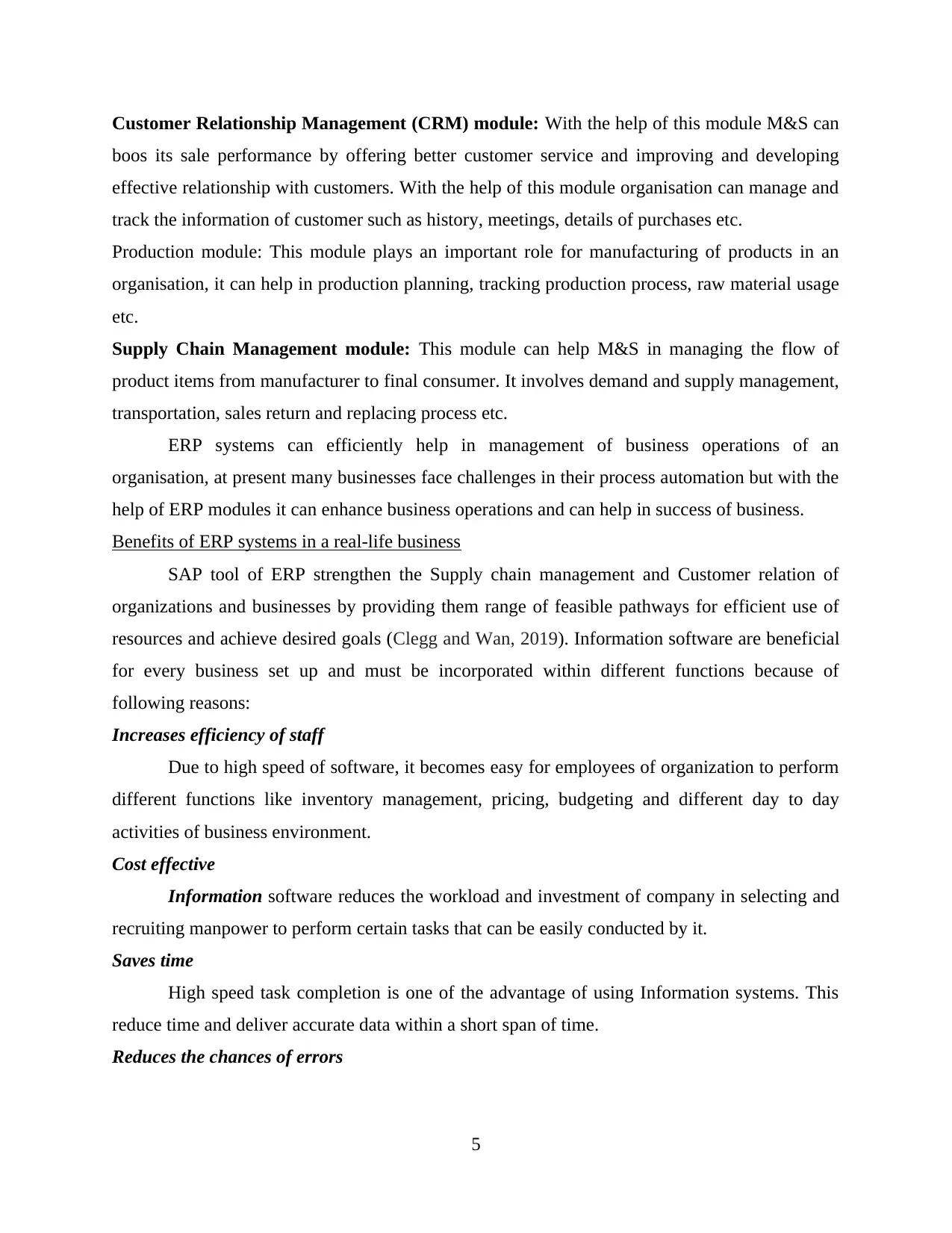
Customer Relationship Management (CRM) module: With the help of this module M&S can
boos its sale performance by offering better customer service and improving and developing
effective relationship with customers. With the help of this module organisation can manage and
track the information of customer such as history, meetings, details of purchases etc.
Production module: This module plays an important role for manufacturing of products in an
organisation, it can help in production planning, tracking production process, raw material usage
etc.
Supply Chain Management module: This module can help M&S in managing the flow of
product items from manufacturer to final consumer. It involves demand and supply management,
transportation, sales return and replacing process etc.
ERP systems can efficiently help in management of business operations of an
organisation, at present many businesses face challenges in their process automation but with the
help of ERP modules it can enhance business operations and can help in success of business.
Benefits of ERP systems in a real-life business
SAP tool of ERP strengthen the Supply chain management and Customer relation of
organizations and businesses by providing them range of feasible pathways for efficient use of
resources and achieve desired goals (Clegg and Wan, 2019). Information software are beneficial
for every business set up and must be incorporated within different functions because of
following reasons:
Increases efficiency of staff
Due to high speed of software, it becomes easy for employees of organization to perform
different functions like inventory management, pricing, budgeting and different day to day
activities of business environment.
Cost effective
Information software reduces the workload and investment of company in selecting and
recruiting manpower to perform certain tasks that can be easily conducted by it.
Saves time
High speed task completion is one of the advantage of using Information systems. This
reduce time and deliver accurate data within a short span of time.
Reduces the chances of errors
5
boos its sale performance by offering better customer service and improving and developing
effective relationship with customers. With the help of this module organisation can manage and
track the information of customer such as history, meetings, details of purchases etc.
Production module: This module plays an important role for manufacturing of products in an
organisation, it can help in production planning, tracking production process, raw material usage
etc.
Supply Chain Management module: This module can help M&S in managing the flow of
product items from manufacturer to final consumer. It involves demand and supply management,
transportation, sales return and replacing process etc.
ERP systems can efficiently help in management of business operations of an
organisation, at present many businesses face challenges in their process automation but with the
help of ERP modules it can enhance business operations and can help in success of business.
Benefits of ERP systems in a real-life business
SAP tool of ERP strengthen the Supply chain management and Customer relation of
organizations and businesses by providing them range of feasible pathways for efficient use of
resources and achieve desired goals (Clegg and Wan, 2019). Information software are beneficial
for every business set up and must be incorporated within different functions because of
following reasons:
Increases efficiency of staff
Due to high speed of software, it becomes easy for employees of organization to perform
different functions like inventory management, pricing, budgeting and different day to day
activities of business environment.
Cost effective
Information software reduces the workload and investment of company in selecting and
recruiting manpower to perform certain tasks that can be easily conducted by it.
Saves time
High speed task completion is one of the advantage of using Information systems. This
reduce time and deliver accurate data within a short span of time.
Reduces the chances of errors
5
Paraphrase This Document
Need a fresh take? Get an instant paraphrase of this document with our AI Paraphraser

The occurrence of errors in outcomes reduces if business related activities are conducted
with the help of information systems
Secures Data
These systems are highly confined with security coding that can't be breach easily (Meyr,
Wagner and Rohde, 2015). Data entered or analyzed using system software are protected with
high internal security protocols.
Customer Services
With the help of ERP system M&S's sales team will be able to focus of offering the best
customer service by building strong customer relationship and maintaining it, which helps in
customer acquisition and retention. ERP can provide M&S with better customer interaction
which helps in improving customer service.
Standardized Business processes
ERP systems are developed according to industry best practices, thus it allows to
standardize the system and processes according the business of M&S which can enhance
productivity and efficiency of the organisation. Due this Organisation can deliver consistent
results which help in improving the ways of operating business.
CONCLUSION
This report concludes that information of the organisation can be managed by using
different technologies and effective management of information can result in the organisational
success. It can also be concluded from the report that there are various types of information
system which can be adopted by an organisation. Present report also concludes that ERP system
can prove important for an organisation, as it helps in managing different functions of an
organisation by adopting different modules of ERP in an organisation. The report has
summarized that inclusion of information systems for business activities is an elementary and
effective decision that must be adopted every large, medium or small business enterprises.
Managerial functions have evolved and become efficient by the help of management information
systems. Furthermore, the study has derived a fact that inclusions of different information
software for each of its department has not only reduces workload of task force but also
empower them regarding different developing business technologies.
6
with the help of information systems
Secures Data
These systems are highly confined with security coding that can't be breach easily (Meyr,
Wagner and Rohde, 2015). Data entered or analyzed using system software are protected with
high internal security protocols.
Customer Services
With the help of ERP system M&S's sales team will be able to focus of offering the best
customer service by building strong customer relationship and maintaining it, which helps in
customer acquisition and retention. ERP can provide M&S with better customer interaction
which helps in improving customer service.
Standardized Business processes
ERP systems are developed according to industry best practices, thus it allows to
standardize the system and processes according the business of M&S which can enhance
productivity and efficiency of the organisation. Due this Organisation can deliver consistent
results which help in improving the ways of operating business.
CONCLUSION
This report concludes that information of the organisation can be managed by using
different technologies and effective management of information can result in the organisational
success. It can also be concluded from the report that there are various types of information
system which can be adopted by an organisation. Present report also concludes that ERP system
can prove important for an organisation, as it helps in managing different functions of an
organisation by adopting different modules of ERP in an organisation. The report has
summarized that inclusion of information systems for business activities is an elementary and
effective decision that must be adopted every large, medium or small business enterprises.
Managerial functions have evolved and become efficient by the help of management information
systems. Furthermore, the study has derived a fact that inclusions of different information
software for each of its department has not only reduces workload of task force but also
empower them regarding different developing business technologies.
6
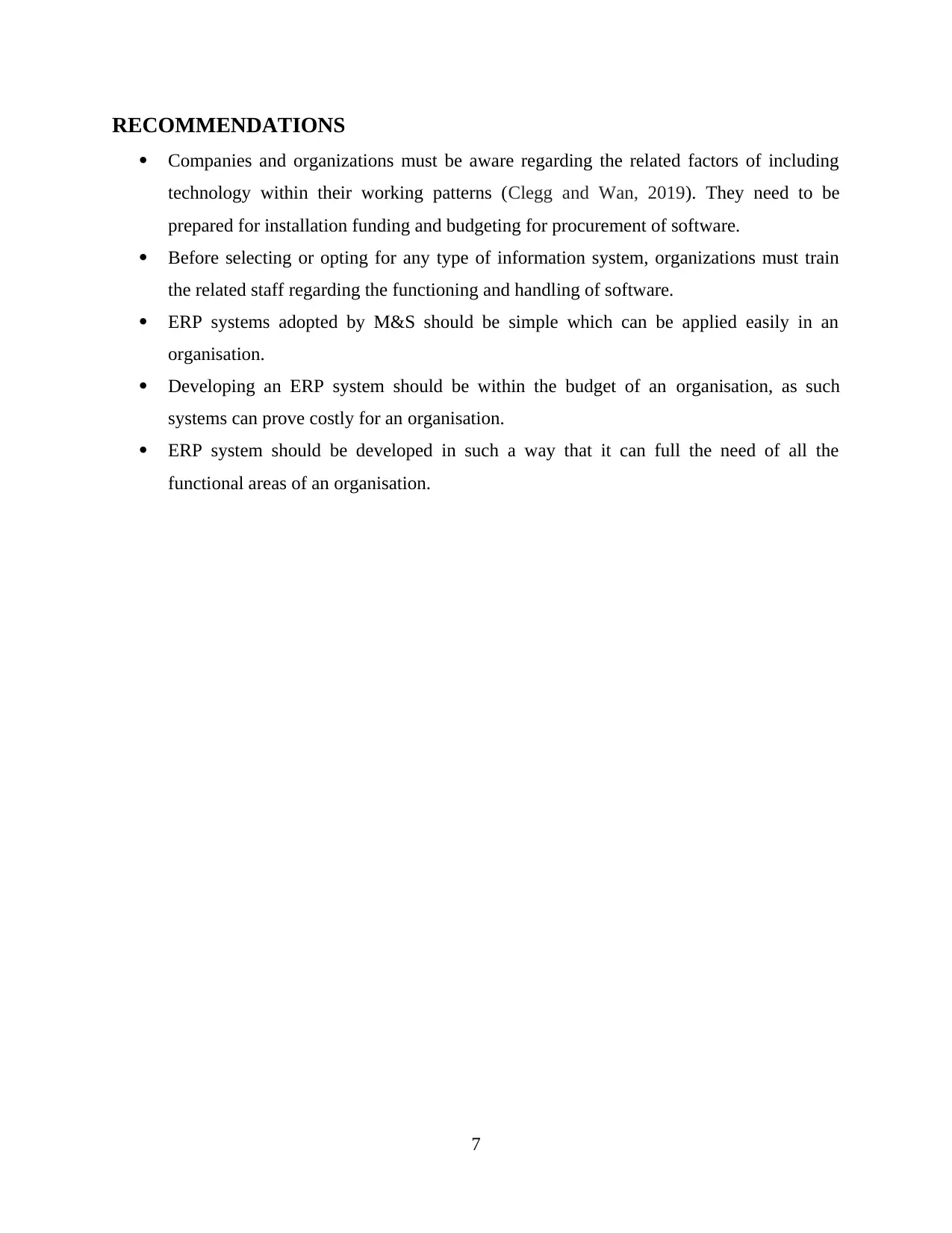
RECOMMENDATIONS
Companies and organizations must be aware regarding the related factors of including
technology within their working patterns (Clegg and Wan, 2019). They need to be
prepared for installation funding and budgeting for procurement of software.
Before selecting or opting for any type of information system, organizations must train
the related staff regarding the functioning and handling of software.
ERP systems adopted by M&S should be simple which can be applied easily in an
organisation.
Developing an ERP system should be within the budget of an organisation, as such
systems can prove costly for an organisation.
ERP system should be developed in such a way that it can full the need of all the
functional areas of an organisation.
7
Companies and organizations must be aware regarding the related factors of including
technology within their working patterns (Clegg and Wan, 2019). They need to be
prepared for installation funding and budgeting for procurement of software.
Before selecting or opting for any type of information system, organizations must train
the related staff regarding the functioning and handling of software.
ERP systems adopted by M&S should be simple which can be applied easily in an
organisation.
Developing an ERP system should be within the budget of an organisation, as such
systems can prove costly for an organisation.
ERP system should be developed in such a way that it can full the need of all the
functional areas of an organisation.
7
⊘ This is a preview!⊘
Do you want full access?
Subscribe today to unlock all pages.

Trusted by 1+ million students worldwide

REFERENCE
Books and Journals
Al-Jabri, I. M. and Roztocki, N., 2015. Adoption of ERP systems: Does information
transparency matter?. Telematics and Informatics. 32(2). pp.300-310.
Asprion, P. M., Schneider, B. and Grimberg, F., 2018. ERP Systems Towards Digital
Transformation. In Business Information Systems and Technology 4.0. (pp. 15-29).
Springer, Cham.
Clegg, B. and Wan, Y., 2019. Enterprise Resource Planning (ERP) Systems and Multi-
Organizational Enterprise (MOE) Strategy. In Business Transformations in the Era of
Digitalization. (pp. 52-75). IGI Global.
Haddara, M., 2018. ERP systems selection in multinational enterprises: a practical guide.
International Journal of Information Systems and Project Management. 6(1). pp.43-57.
Meyr, H., Wagner, M. and Rohde, J., 2015. Structure of advanced planning systems. In Supply
chain management and advanced planning. (pp. 99-106). Springer, Berlin, Heidelberg.
Sardo, F. and Alves, M. C., 2018. ERP Systems and Accounting: A Systematic Literature
Review. International Journal of Enterprise Information Systems (IJEIS). 14(3). pp.1-
18.
Schlichter, J., Klyver, K. and Haug, A., 2018. The Moderating Effect of ERP System
Complexity on the Growth–Profitability Relationship in Young SMEs. Journal of Small
Business Management.
Foote, A. and Halawi, L. A., 2018. Knowledge management models within information
technology projects. Journal of Computer Information Systems. 58(1). pp.89-97.
Onyango, R., 2018. Information resources and technology transfer management in developing
countries. Routledge.
Judrups, J., 2015. Analysis of knowledge management and e-learning integration models.
Procedia Computer Science. 43.pp.154-162.
Online
5 Enterprise Resource Planning (ERP) Trends to Watch in 2019. [Online]. Available through:
<https://erpinnews.com/5-enterprise-resource-planning-erp-trends-to-watch-in-2019>.
ERP (Enterprise Resource Planning). 2018. [Online]. Available through: <http://www.tech-
faq.com/erp.html>.
8
Books and Journals
Al-Jabri, I. M. and Roztocki, N., 2015. Adoption of ERP systems: Does information
transparency matter?. Telematics and Informatics. 32(2). pp.300-310.
Asprion, P. M., Schneider, B. and Grimberg, F., 2018. ERP Systems Towards Digital
Transformation. In Business Information Systems and Technology 4.0. (pp. 15-29).
Springer, Cham.
Clegg, B. and Wan, Y., 2019. Enterprise Resource Planning (ERP) Systems and Multi-
Organizational Enterprise (MOE) Strategy. In Business Transformations in the Era of
Digitalization. (pp. 52-75). IGI Global.
Haddara, M., 2018. ERP systems selection in multinational enterprises: a practical guide.
International Journal of Information Systems and Project Management. 6(1). pp.43-57.
Meyr, H., Wagner, M. and Rohde, J., 2015. Structure of advanced planning systems. In Supply
chain management and advanced planning. (pp. 99-106). Springer, Berlin, Heidelberg.
Sardo, F. and Alves, M. C., 2018. ERP Systems and Accounting: A Systematic Literature
Review. International Journal of Enterprise Information Systems (IJEIS). 14(3). pp.1-
18.
Schlichter, J., Klyver, K. and Haug, A., 2018. The Moderating Effect of ERP System
Complexity on the Growth–Profitability Relationship in Young SMEs. Journal of Small
Business Management.
Foote, A. and Halawi, L. A., 2018. Knowledge management models within information
technology projects. Journal of Computer Information Systems. 58(1). pp.89-97.
Onyango, R., 2018. Information resources and technology transfer management in developing
countries. Routledge.
Judrups, J., 2015. Analysis of knowledge management and e-learning integration models.
Procedia Computer Science. 43.pp.154-162.
Online
5 Enterprise Resource Planning (ERP) Trends to Watch in 2019. [Online]. Available through:
<https://erpinnews.com/5-enterprise-resource-planning-erp-trends-to-watch-in-2019>.
ERP (Enterprise Resource Planning). 2018. [Online]. Available through: <http://www.tech-
faq.com/erp.html>.
8
1 out of 10
Related Documents
Your All-in-One AI-Powered Toolkit for Academic Success.
+13062052269
info@desklib.com
Available 24*7 on WhatsApp / Email
![[object Object]](/_next/static/media/star-bottom.7253800d.svg)
Unlock your academic potential
Copyright © 2020–2025 A2Z Services. All Rights Reserved. Developed and managed by ZUCOL.




